|
Sunday:
March 21, 2004 | |
0646 GMT |
 |
Newest GPS spacecraft successfully soars into orbit
As the 50th Global Positioning System satellite rose to space Saturday, it celebrated the man who championed the concept of orbiting spacecraft serving as "lighthouses in the sky" to guide mankind with precision navigation information.
 FULL STORY FULL STORY
 MISSION STATUS CENTER MISSION STATUS CENTER
 |  |

|
 |

Video coverage for subscribers only:
 VIDEO:
DELTA 2 ROCKET BLASTS OFF WITH GPS 2R-11 QT VIDEO:
DELTA 2 ROCKET BLASTS OFF WITH GPS 2R-11 QT
 VIDEO:
LONGER LENGTH LAUNCH MOVIE QT VIDEO:
LONGER LENGTH LAUNCH MOVIE QT
 VIDEO:
SPACECRAFT SEPARATION ANNOUNCED QT VIDEO:
SPACECRAFT SEPARATION ANNOUNCED QT
 VIDEO:
FIRST COUNTDOWN HALTED BY ALARM QT VIDEO:
FIRST COUNTDOWN HALTED BY ALARM QT
 SUBSCRIBE NOW SUBSCRIBE NOW

|
Pad to be refurbished for time-critical launch
For the Delta launch team at Cape Canaveral, there is little time to spare following Saturday's successful mission as workers refurbish pad 17B for its next mission.
 FULL STORY FULL STORY
 |  |
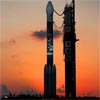
|
 |
'Fab five' make rare appearance in night sky
Like a busy urban family, planets rarely get together all at once. Later this month, however, the five so-called naked-eye planets - Mercury, Venus, Mars, Jupiter and Saturn - will reunite in the night sky, giving spectators a unique chance to see Earth's closest companions in one easy sitting.
 FULL STORY FULL STORY
 |  |

|
 |
|
Saturday:
March 20, 2004 | |
0358 GMT |
 |
Delta 2 rocket to launch GPS satellite Saturday
The 50th Global Positioning System satellite will be launched Saturday to sustain the space-based navigation constellation. Liftoff atop Boeing's Delta 2 rocket is scheduled for 12:39 p.m. EST (1739 GMT) from Cape Canaveral, Florida.
 MISSION STATUS CENTER - updates MISSION STATUS CENTER - updates
 PREVIEW STORY PREVIEW STORY
 |  |
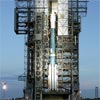
|
 |
Analysts get glory for Global Position System work
As the world anticipated the war in Iraq in early 2003, two navigation analysts at Schriever Air Force Base began to conjure up ways to improve Global Position System accuracy.
 FULL STORY FULL STORY
 |  |

|
 |
New imagery of comet released from Stardust
NASA's Stardust spacecraft successfully survived flying through the dust and gas cloud surrounding comet Wild 2 in January. During the flyby, the highest resolution images ever taken of a comet's nucleus were obtained and have been the subject of intense study since the flyby.
 FULL STORY FULL STORY
 |  |

|
 |
NEWSWIRE Links to news across the internet
|
 |
Pentagon spurs spy satellite business -- (Reuters) The Pentagon said on Friday it will seek commercial bids for a new contract worth roughly $500 million to supply spy-quality pictures from space.
|
 |
|
Friday:
March 19, 2004 | |
0257 GMT |
 |
Mineral in Mars 'berries' adds to water story
A major ingredient in small mineral spheres analyzed by NASA's Mars Exploration Rover Opportunity furthers understanding of past water at Opportunity's landing site and points to a way of determining whether the vast plains surrounding the site also have a wet history.
 FULL STORY FULL STORY
 |  |

|
 |
Water at Martian south pole
Thanks to Europe's Mars Express, we now know that Mars has vast fields of perennial water ice, stretching out from the south pole of the Red Planet. Astronomers have known for years that Mars possessed polar ice caps, but early attempts at chemical analysis suggested only that the northern cap could be composed of water ice, and the southern cap was thought to be carbon dioxide ice.
 FULL STORY FULL STORY
 |  |

|
 |
IN OTHER NEWS Additional stories making news today
|
 |
General Dynamics to acquire Spectrum Astro -- General Dynamics announced today that it has entered into a definitive agreement to acquire Gilbert, Ariz.-based Spectrum Astro, Inc., a privately held space systems integrator for the U.S. government.
|
 |
NEWSWIRE Links to news across the internet
|
 |
Astronauts try to save Hubble telescope -- (Associated Press) They risked their lives for the Hubble Space Telescope and did so gladly. Now, many of the astronauts who worked on Hubble hundreds of miles above Earth are dismayed, bewildered or both by NASA's decision to pull the plug on the mighty observatory.

|
 |
|
Thursday:
March 18, 2004 | |
1515 GMT |
 |
U.S. military ready to launch its 50th GPS satellite
Serving mankind as a "lighthouse in the sky," the 50th Global Positioning System satellite launches Saturday to sustain the space-based navigation constellation. Liftoff atop Boeing's Delta 2 rocket is scheduled for 12:39 p.m. EST (1739 GMT) from Cape Canaveral, Florida.
 LAUNCH PREVIEW STORY LAUNCH PREVIEW STORY
 MISSION STATUS CENTER MISSION STATUS CENTER
 |  |
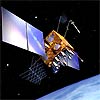
|
 |
Satellite solves 30-year gamma-ray mystery
ESA's Integral gamma-ray observatory has resolved the diffuse glow of
gamma rays in the center of our galaxy and has shown that most of it is
produced by a hundred individual sources. Integral detected these celestial objects where all other telescopes, for more than thirty years, had seen nothing
but a mysterious, blurry fog of gamma rays.
 FULL STORY FULL STORY
 |  |

|
 |
IN OTHER NEWS Additional stories making news today
|
 |
Intelsat completes acquisition of Loral satellites -- Intelsat announced Wednesday that it has completed its acquisition of the North American satellites and related customer contracts of Loral Space & Communications Corporation. The Telstar satellites have been renamed "Intelsat Americas."
|
 |
NEWSWIRE Links to news across the internet
|
 |
100-foot asteroid to make closest pass -- (Associated Press) As far as flying space rocks go, it's as close an encounter as mankind has ever had. A 100-foot diameter asteroid will pass within 26,500 miles of Earth on Thursday evening, the closest-ever brush on record by a space rock, NASA astronomers said.

Space program leaders blamed for Brazil accident -- (Associated Press) Poor funding and lax management contributed to the accidental explosion of a rocket that killed 21 engineers and technicians three days before launch last year, a report on the disaster said Tuesday.

Mars mission criticized by spending group -- (Associated Press) A public spending watchdog criticized scientists behind the doomed Beagle 2 mission to Mars Tuesday for neglecting to highlight the chances of mission failure when they applied for British government funding.
|
 |
|
Wednesday:
March 17, 2004 | |
0437 GMT |
 |
SOHO spacecraft snaps spectacular Sun shot
Last Friday the Sun ejected a spectacular "eruptive prominence" into the heliosphere. SOHO, the ESA/NASA solar watchdog observatory, faithfully recorded the event.
 FULL STORY FULL STORY
 |  |

|
 |
Satellite finds warming 'relative' to humidity
A NASA-funded study found some climate models might be overestimating the amount of water vapor entering the atmosphere as the Earth warms. Since water vapor is the most important heat-trapping greenhouse gas in our atmosphere, some climate forecasts may be overestimating future temperature increases.
 FULL STORY FULL STORY
 |  |

|
 |
IN OTHER NEWS Additional stories making news today
|
 |
Boeing establishes new space offices -- To better support the President's new space exploration policy, Boeing has established the Space Exploration Systems office and the Earth Science Applications office.

UAV completes first operational flights -- A small, unmanned airplane recently conducted flights along the Virginia coast showing its capability to support NASA science missions.
|
 |
|
Tuesday:
March 16, 2004 | |
1124 GMT |
 |
Most distant object in Solar System discovered
NASA-funded researchers have discovered the most distant object orbiting Earth's Sun. The object is a mysterious planet-like body three times farther from Earth than Pluto.
 FULL STORY FULL STORY
 |  |
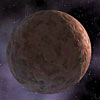
|
 |

Coverage for subscribers only:
 AUDIO: DR. BROWN'S ANNOUNCEMENT OF THIS DISCOVERY QT AUDIO: DR. BROWN'S ANNOUNCEMENT OF THIS DISCOVERY QT
 SUBSCRIBE NOW SUBSCRIBE NOW

|
Spirit rover reveals Bonneville Crater in color
The Mars Exploration Rover Spirit has returned a stunning panorama from the rim of Bonneville Crater. The 180-degree mosaic shows the crater's interior and surrounding terrain. The heat shield that protected Spirit during the fiery descent through the Martian atmosphere is seen sitting on the opposite side of the crater.
 FULL STORY FULL STORY
 |  |

|
 |
Communications satellite put into orbit by Proton
With its six-engine first stage providing a powerful punch, a Russian Proton rocket roared off the planet Monday night carrying an advanced satellite that will relay telecommunications services across Europe, the Mediterranean Basin and sub-Saharan Africa.
 FULL STORY FULL STORY
 MISSION STATUS CENTER MISSION STATUS CENTER
 |  |
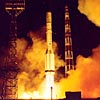
|
 |

Coverage for subscribers only:
 AUDIO: DR. BROWN'S ANNOUNCEMENT OF THIS DISCOVERY QT AUDIO: DR. BROWN'S ANNOUNCEMENT OF THIS DISCOVERY QT
 SUBSCRIBE NOW SUBSCRIBE NOW

|
Six-terabyte sky catalog released to public
One of the largest astronomy catalogs ever compiled was released to the public Monday by the Sloan Digital Sky Survey. With photometric and spectroscopic observations of the sky gathered during the last two years, this second data release offers six terabytes of images and catalogs, including two terabytes in an easy to use searchable database.
 FULL STORY FULL STORY
 |  |

|
 |
|
Monday:
March 15, 2004 | |
0258 GMT |
 |
NASA releases paper detailing Hubble decision
As the controversy continues to swirl around NASA's decision to kill the final Hubble Space Telescope servicing mission, the space agency has responded with a paper explaining the decision. You can read it here:
 FULL STORY FULL STORY
 |  |
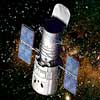
|
 |
Proton to fly marathon launch with W3A satellite
A powerful telecommunications spacecraft to serve Europe, the Middle East and Africa will be lofted into orbit Monday night by a Russian Proton rocket.
 MISSION STATUS CENTER MISSION STATUS CENTER
 |  |

|
 |
Discovery of unusual solar object to be revealed
Uncovering the most distant object ever detected orbiting the sun will be the subject of a NASA news conference on Monday at 1 p.m. EST. Dr. Michael Brown, associate professor of planetary astronomy at the California Institute of Technology will present his discovery of this mysterious object in our solar system.
 |  |
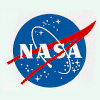
|
 |
IN OTHER NEWS Additional stories making news today
|
 |
Celebrating the legacy of Challenger astronaut -- Ceremonial events of remembrance and celebration of the legacy of Challenger astronaut Dr. Ronald E. McNair will be held Monday in McNair's hometown, Lake City, S.C. Lake City recently relocated McNair's remains to the Dr. Ronald E. McNair Memorial Park. The city is hosting a series of
special events to mark the 18th anniversary year of the Challenger accident and to acknowledge the new resting place.

Major donation for cosmology institute -- The University of Chicago will devote $7.5 million in donations from Fred Kavli and the Kavli Foundation of Oxnard, Calif., to studying some of the most puzzling scientific questions about the origin and evolution of the universe and the laws that govern it.
|
 |

